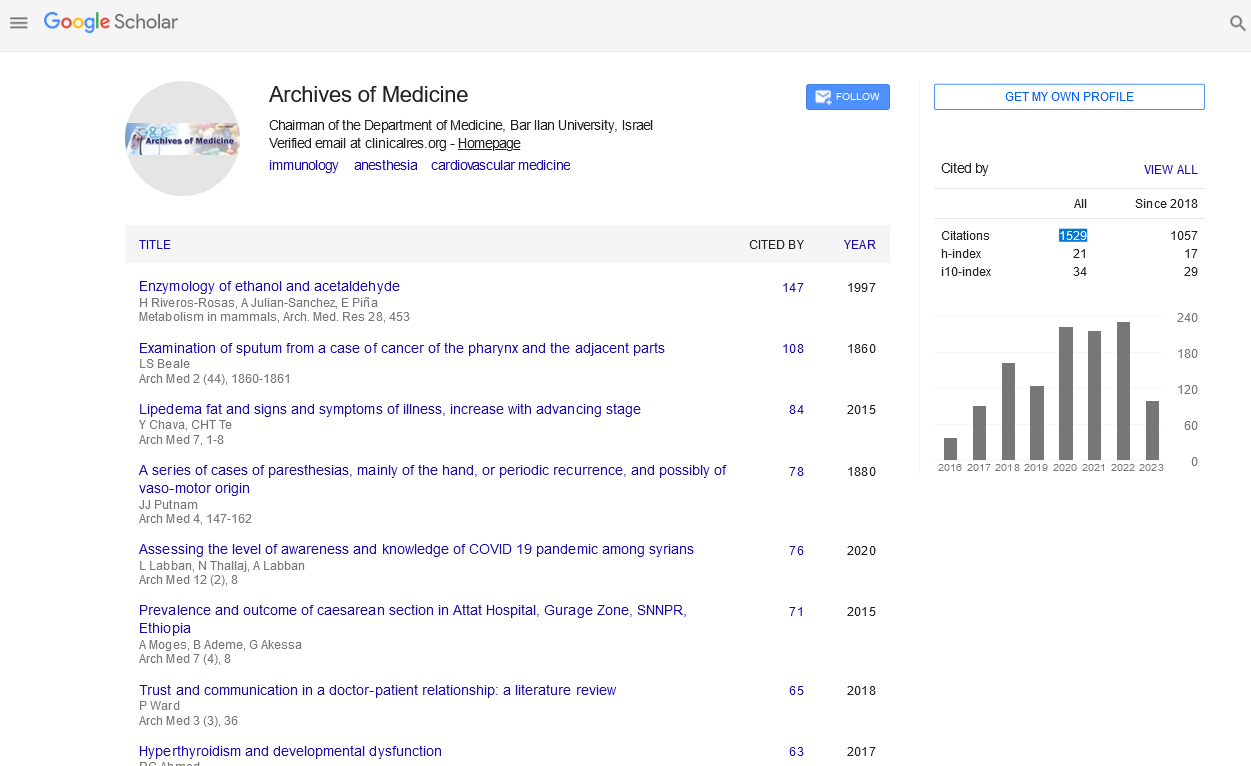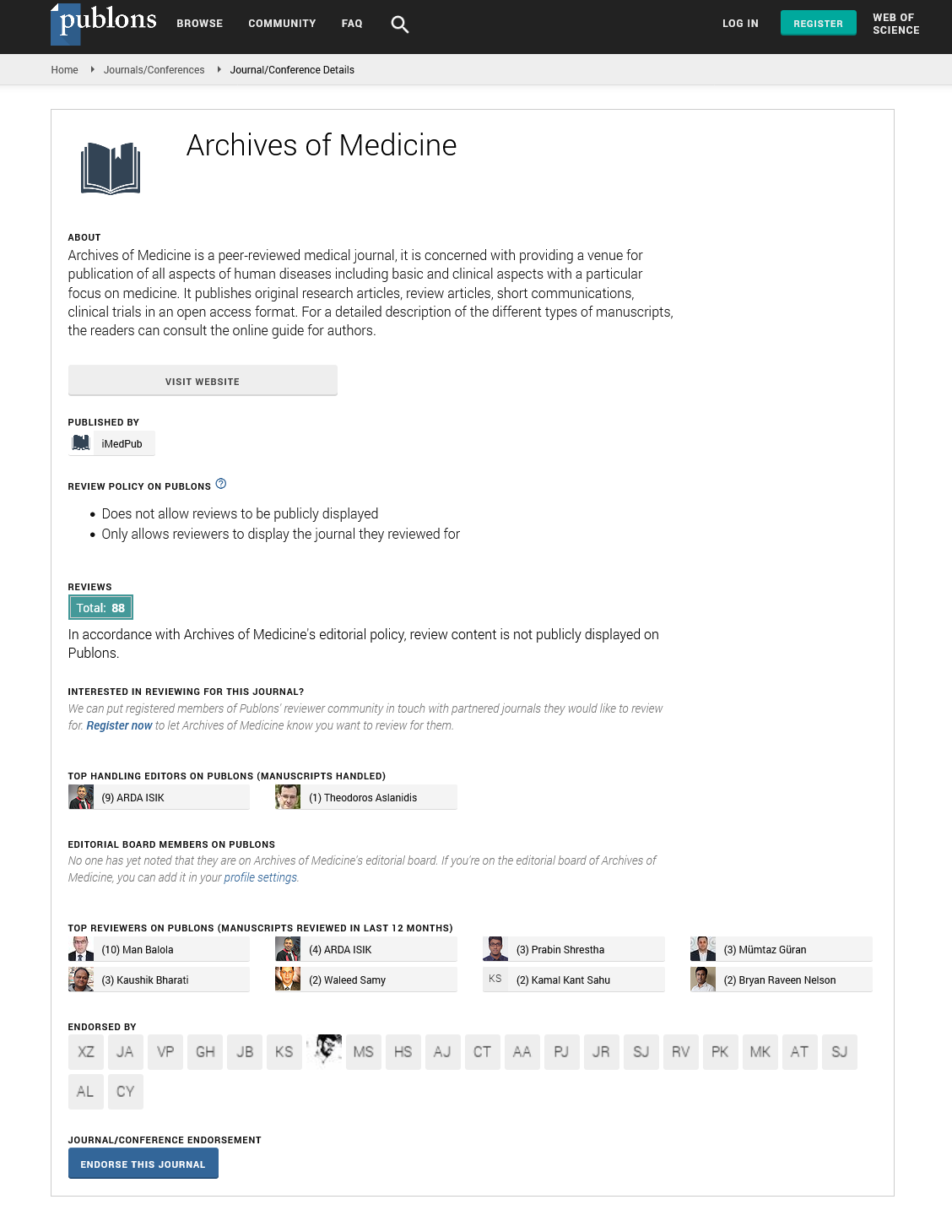Mini Review - (2023) Volume 15, Issue 5
Stroke treatment and rehabilitation: Integrative medicine's clinical practice guideline: A review
Guang Ji*
Department of Digestive Disease, Longhua Hospital, Shanghai University of Traditional Chinese Medicine, Shanghai 200032, China
*Correspondence:
Guang Ji, Department of Digestive Disease, Longhua Hospital, Shanghai University of Traditional Chinese Medicine, Shanghai 200032,
China,
Email:
Received: 22-Aug-2023, Manuscript No. ipaom-23-14122;
Editor assigned: 24-Aug-2023, Pre QC No. P-14122;
Reviewed: 06-Sep-2023, QC No. Q-14122;
Revised: 12-Sep-2023, Manuscript No. R-14122;
Published:
19-Sep-2023
Abstract
Stroke is the second-leading global cause of death. About 6.8% of
all fatalities in Hong Kong might be attributed to cerebrovascular
disease. There are presently no recommendations to support the
related professional practice for the treatment and rehabilitation of
stroke, despite the fact that patients commonly employ integrative
medicine treatments. As a result, we developed this framework for
the development of an integrated clinical practice guideline for
stroke.
Keywords
Clinical practice guideline; Stroke; Integrative medicine;
Stroke rehabilitation
Introduction
Over 11% of all fatalities occur due to stroke, which
includes ischemic and hemorrhagic stroke. Stroke is the
second most prevalent cause of death worldwide. About
6.8% of all fatalities in Hong Kong might be attributed
to cerebrovascular disease. Although stroke predominantly
impacts neurological function, it also causes a considerable
loss of years of healthy life because of serious post-stroke
consequences include paralysis, aphasia, dysphagia, epilepsy,
cognitive issues and depression. Clinicians need extensive
suggestions from a range of disciplines in order to provide
the best assistance in their everyday clinical practice because
of these significant problems. Standard stroke therapy in
various Asian nations often mixes Western medicine with
complementary therapies like Chinese medicine [1].
Literature Review
The two primary pillars of integrated medicine in
this paradigm (CM) are Western medicine (WM) and
Chinese medicine. CM has been often combined with
WM treatments in various stages of stroke, making it one
of the most widely utilized stroke treatment modalities
among Chinese communities. CM developed a conceptual
framework for illness prevention, diagnosis, treatment and
prognosis over thousands of years that is very different
from WM. Patients who want assistance typically look
for practitioners of both WM and CM because of the
widespread acceptability and popularity of CM in Hong
Kong. Due to Hong Kong's unique restrictions, the
implementation of these integrative procedures without
practice standards and effective communication between
WM and CM has raised safety concerns.
It will be decided to form a multidisciplinary
guidelines committee of statisticians, speech therapists,
psychotherapists, occupational therapists, physiotherapists,
neurological experts and CM specialists. The four main
groups will be the steering committee, the systematic
review group, the recommendation formulation panel and
a group of methodological experts. The systematic review
group will be in charge of conducting a systematic search for
relevant evidence, evaluating the quality of relevant studies
and synthesizing data. The recommendation development
panel will be in charge of creating the recommendations
list and implementing a consensus method for expert
opinion. Clarifying the scope, objective, target audience
and users of the guideline will be the responsibility of the
steering group. The appendix will provide a list of all the
specific information on each member of the guidelines
development committee [2,3].
The creating proposal board will be responsible for
composing the underlying adaptation of suggestions in
view of the GRADE discoveries, the expense productivity
of the innovation, genuine clinical assets and the adequacy
of the medicines. A two-round Delphi study will be utilized
to arrive at an agreement utilizing the master agreement
approach. The points of interest of CM guidance,
including condition classifications (disorder qualification),
CM home grown equation portion, needle therapy mode
(like manual, warm, or electroacupuncture) and acupoints,
will be examined.
Discussion
In excess of 6000 enlisted CM specialists work in
Hong Kong. Be that as it may, there are no coordinated or
CM rules open to coordinate CM clinical practice. Most
of CM experts base their decisions on their own clinical
mastery and encounters. Moreover, the principal Chinese
Medication Clinic in Hong Kong, which will offer both
ongoing and short term medicines, is expected to be done
inside the following three years. To arrange the clinical
elements of the WM and CM centers and emergency
clinics in Hong Kong and to offer patients the most ideal
choices, it is basic to play out an integrative medication
stroke rule that includes both WM and CM treatments [4].
In a rodent ongoing center cerebral vein impediment
(MCAO) worldview, a concentrate by Xia Zhen-Yan shown
that Shengui Sansheng Pulvis, a Chinese natural blend
of Panax ginseng C.A.Mey, root and rhizome, Angelica
sinensis (Oliv.) Diels, root and rhizome and Cinnamomum
cassia (L.) J.Pre Keeping the blood-cerebrum obstruction
flawless after a stroke could be conceivable with it. Another
customary Chinese medication detailing, Dan Zhi tablet,
which contained the spices Astragalus membranaceus
(Fisch.) Bge. var. mongholicus (Bge.) Hsiao (AM), Salvia
miltiorrhiza Bge. ( SM), Ligusticum chuanxiong Hort. (LC), Hirudo nipponica Whitman (HN) and Pheretima
aspergillum.
For the best suggestions to be made, a great rule
should assemble methodical data as well as be pragmatic
and helpful for specialists. The foundation of a rule ought
to empower the right utilization of extra CM treatments
considering the huge CM assets in Hong Kong. Integrative
medication rules would present more exhaustive proposals
than those that solely use WM information, especially
where there is a shortage of powerful WM treatment [5,6].
Future endeavors ought to likewise be made to survey
and screen how proposals are being utilized, as well as to
investigate any expected impacts on their utilization. We
mean to make a clinical course for stroke and a treatment
calculation as the following stage in this review to assist
significant experts with following our proposals.
Conclusion
The stroke not just represents a significant gamble to
one's wellbeing yet additionally loads both the individual
and society with a lot of disorder. Hence, improving
patient visualization and give experts the smartest ideas
possible is urgent. This study accentuates the capability of
correlative medication (CM) during the time spent stroke
care and delineates how to play out the clinical practice
rules for stroke the executives that blend integrative
medication information. Furthermore, this approach could
act as a systemic aide for creating incorporated medication
suggestions for treating extra issues.
Acknowledgement
None.
Conflict of Interest
None.
References
- Stratakis N, Roumeliotaki T, Oken E, et al. Fish and seafood consumption during pregnancy and the risk of asthma and allergic rhinitis in childhood: A pooled analysis of 18 European and US birth cohorts. Int J Epidemiol. 2017;46(5):1465-77.
Google Scholar, Crossref, Indexed at
- Pastor-Vargas C, Maroto AS, Díaz-Perales A, et al. Detection of major food allergens in amniotic fluid: Initial allergenic encounter during pregnancy. Pediatr Allergy Immunol. 2016;27(7):716-20.
Google Scholar, Crossref, Indexed at
- Kramer MS, Kakuma R. Maternal dietary antigen avoidance during pregnancy or lactation, or both, for preventing or treating atopic disease in the child. Evidence-Based Child Health. 2014;9(2):447-83.
Google Scholar, Crossref, Indexed at
- Litonjua AA, Carey VJ, Laranjo N, et al. Effect of prenatal supplementation with vitamin D on asthma or recurrent wheezing in offspring by age 3 years: The VDAART randomized clinical trial. Jama. 2016;315(4):362-70.
Google Scholar, Crossref, Indexed at
- Gunaratne AW, Makrides M, Collins CT, et al. Maternal prenatal and/or postnatal n3 long chain polyunsaturated fatty acids (LCPUFA) supplementation for preventing allergies in early childhood. Cochrane Database Syst Rev. 2015(7).
Google Scholar, Crossref, Indexed at
- Berger AM, Farr LA, Kuhn BR, et al. Values of sleep/wake, activity/rest, circadian rhythms and fatigue prior to adjuvant breast cancer chemotherapy. J Pain Symptom Manag. 2007;33(4):398-409.
Google Scholar, Crossref, Indexed at






